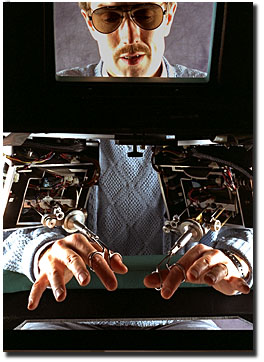|
||||||
|
||||||
 Overall view of SRI International's remote telepresence surgery system. Joel Jensen, SRI Senior R and D engineer, Medical Technology Laboratory, operates the device which senses the surgeon's hands and transfers movements via servo motors, over wires. This technology might someday become common practice on the Internet. (Photograph by Kim Komenich ) |
 n the battlefield of the future, a wounded soldier's life could be
saved by a surgeon operating hundreds of miles away in cyberspace.
n the battlefield of the future, a wounded soldier's life could be
saved by a surgeon operating hundreds of miles away in cyberspace. That's the vision driving the Telepresence Surgery research program at SRI International in Menlo Park, Calif. With a combination of medicine, robotics and networking technology, the company has built a "telepresence workstation" that allows a surgeon in one place to operate on a patient in another. The workstation provides all the audio, visual and other sensory information needed to perform the operation. "It's a fully immersive interface. As the surgeon touches the tissue, he feels the tissue," says Dr. Ajit Shah, director of SRI's medical technology laboratory. "If he pushes down on the tissue, he can feel if it's a hard surface or a soft surface." The surgeon manipulates the Remote Slave Unit, which extends over the patient and is connected to the surgeon's console via high-speed cables. The RSU is outfitted with robotic arms, high resolution cameras, stereo microphones, force-reflecting slave manipulators and interchangeable tools. |

|
|
Surgery on humans is about a year off, but 11 pigs have undergone successful operations.
To date, surgeon and patient have been 500 feet apart at most and connected by
cables. But if a wireless system is developed, surgeon and patient could be
separated by as much as 1,000 miles. Shah's research has been underway for about five years and currently is funded by the Advanced Research Projects Agency. A main goal of the effort is to reduce the number of soldiers who die in battle because they can't receive surgery in time, says Shah. |
|
|

|
Please direct all inquiries to: cyber24rs@aol.com
©1996, 24 Hours in Cyberspace Inc., All Rights Reserved.


